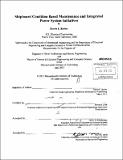Shipboard condition based maintenance and integrated power system initiatives
Author(s)
Barber, Darrin E. (Darrin Eugene)
DownloadFull printable version (15.67Mb)
Other Contributors
Massachusetts Institute of Technology. Dept. of Electrical Engineering and Computer Science.
Advisor
Steven B. Leeb.
Terms of use
Metadata
Show full item recordAbstract
With the U.S. Navy's continued focus on developing and implementing a robust integrated power system aboard future combatants, there has been an ever increasing effort to guarantee an electrical distribution system that maintains maximum capabilities in the event of a system fault. It is believed that the implementation of a device such as a non-intrusive load monitor (NILM) can greatly assist in the preemptive detection of such faults and failures. Ongoing NILM research conducted at Massachusetts Institute of Technology's Laboratory for Electromagnetic and Electronic Systems (LEES) is exploring the application of NILM technology in shipboard environments. The NILM's unique ability to the monitor the power usage profile of these systems can be used to immediately diagnose system casualties and unusual operation parameters. Additionally, research has shown that the NILM can be used effectively and reliably, to monitor equipment health, recognize and indicate abnormal operating conditions and casualties and provide invaluable information for training operators, diagnosing problems and troubleshooting. This thesis will discuss how this frequency content of the aggregate measurement can be used to assess the health of motors. Experiments were conducted in the confines of LESS in addition to aboard USCGC ESCANABA (WMEC-907), a 270-foot Coast Guard Cutter, in order to better understand the system dynamics in a real life environment. To further support the US Navy's integrated power system initiatives two hardware models of a shipboard electrical propulsion drive system were constructed, an MVDC propulsion simulation and a doubly-fed machine propulsion model. These simulations were built for the purpose of testing innovative integrated propulsion system theories, algorithms, configurations and new electric propulsion concepts.
Description
Thesis (Nav. E.)--Massachusetts Institute of Technology, Dept. of Mechanical Engineering; and, (S.M.)--Massachusetts Institute of Technology, Dept. of Electrical Engineering and Computer Science, 2011. Cataloged from PDF version of thesis. Includes bibliographical references (p. 80-81).
Date issued
2011Department
Massachusetts Institute of Technology. Department of Electrical Engineering and Computer Science; Massachusetts Institute of Technology. Department of Mechanical EngineeringPublisher
Massachusetts Institute of Technology
Keywords
Mechanical Engineering., Electrical Engineering and Computer Science.